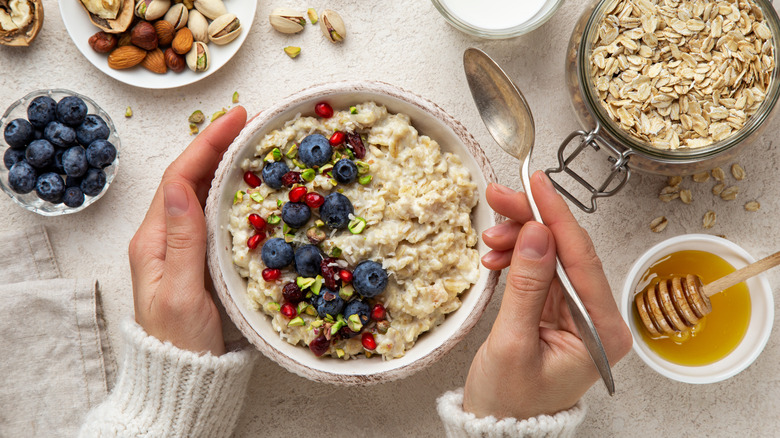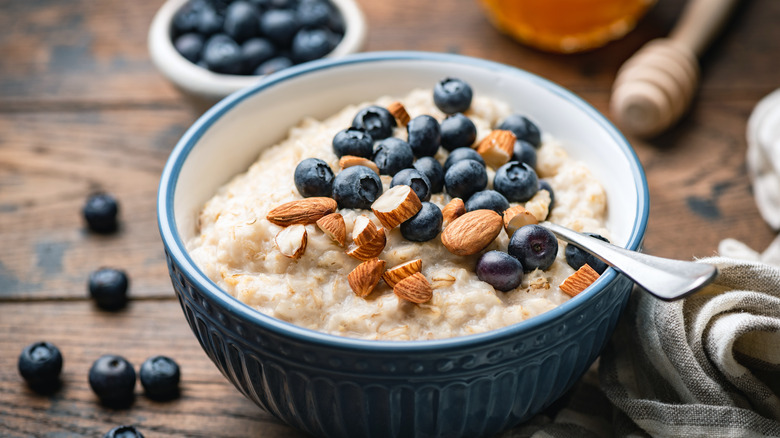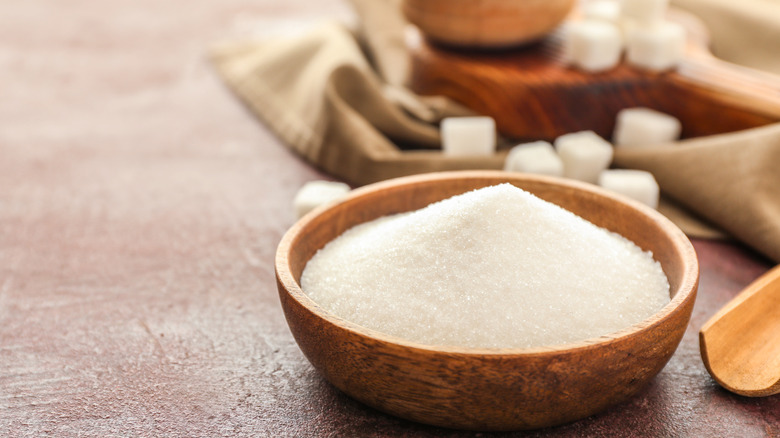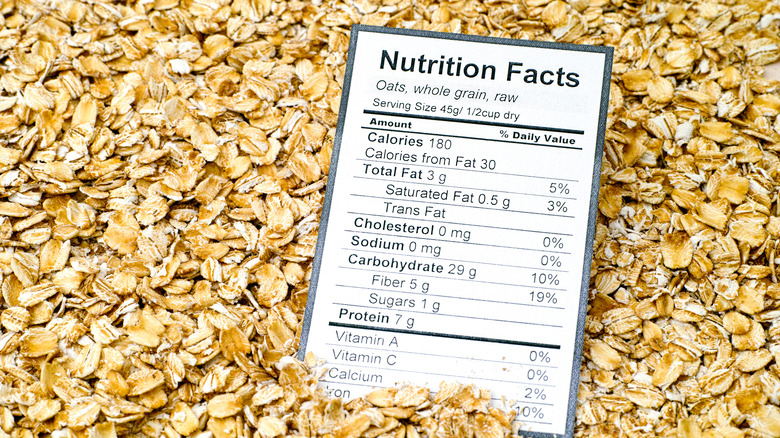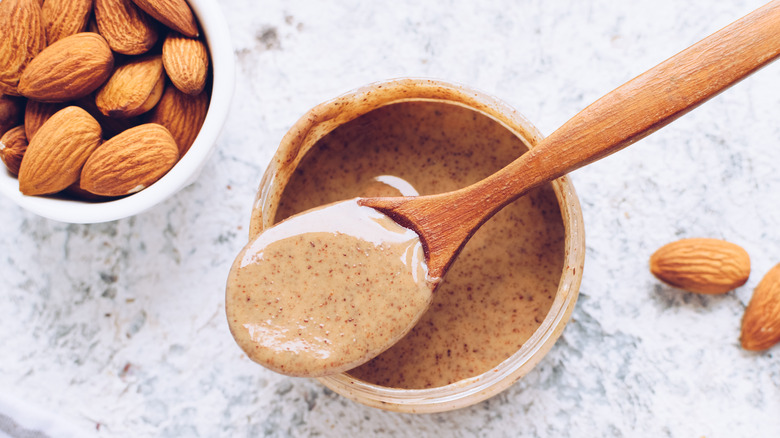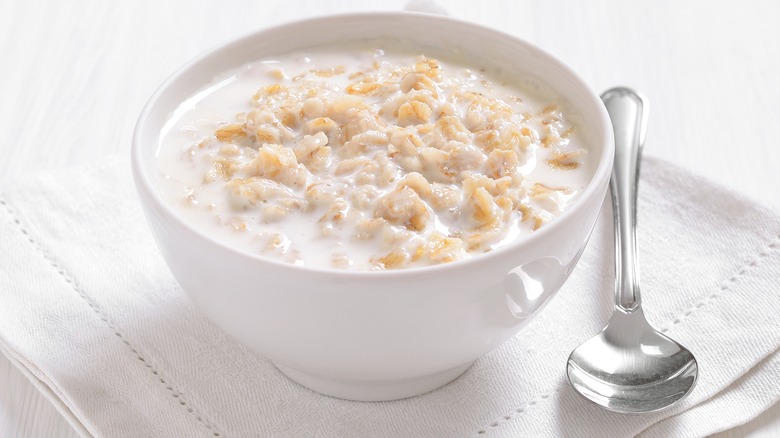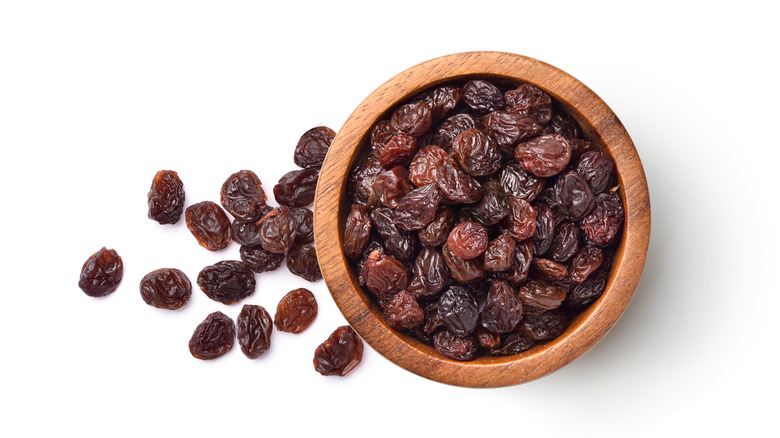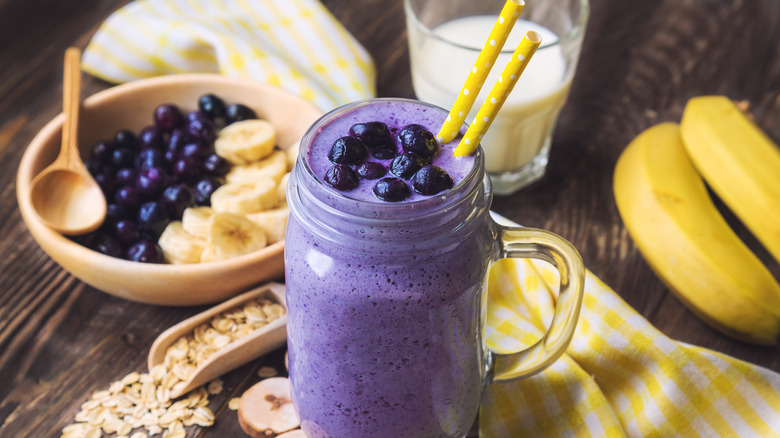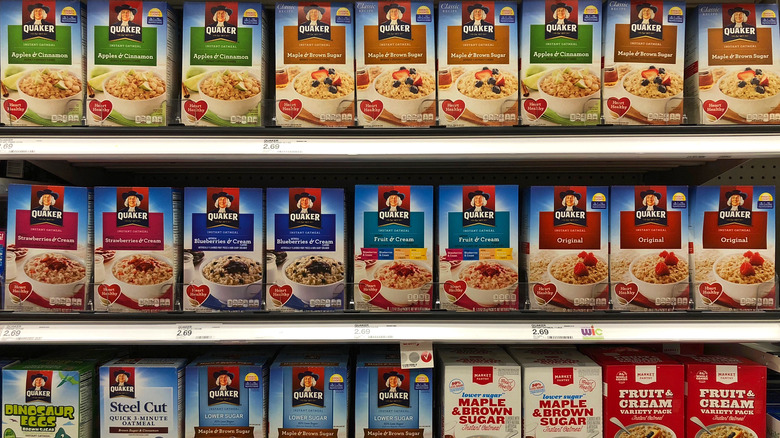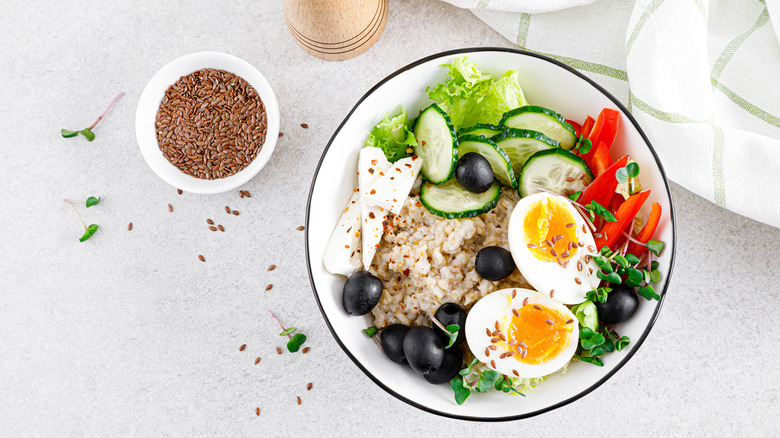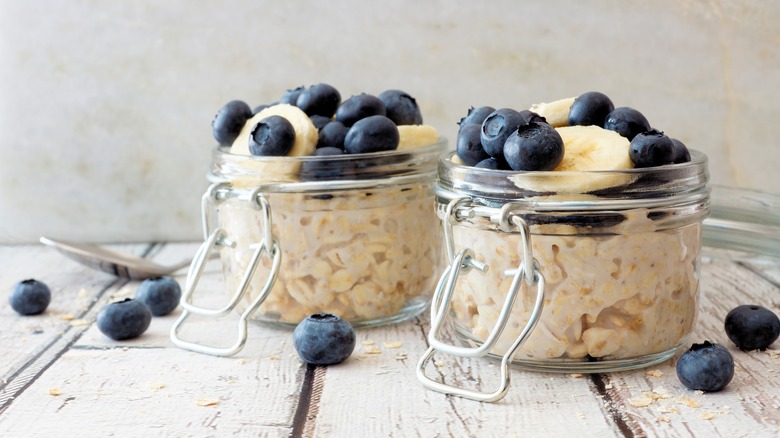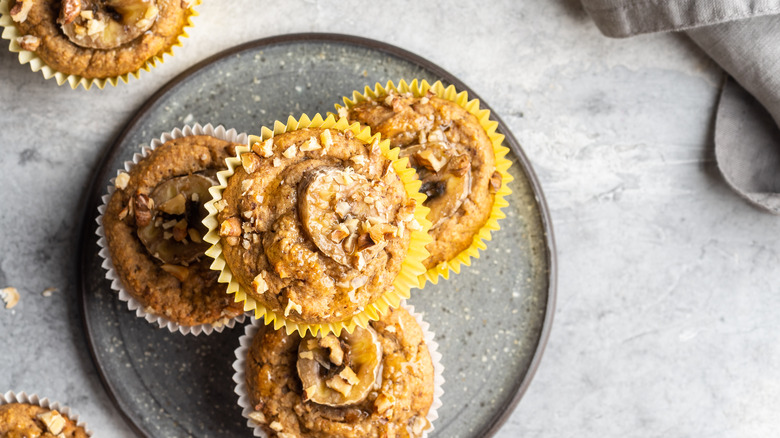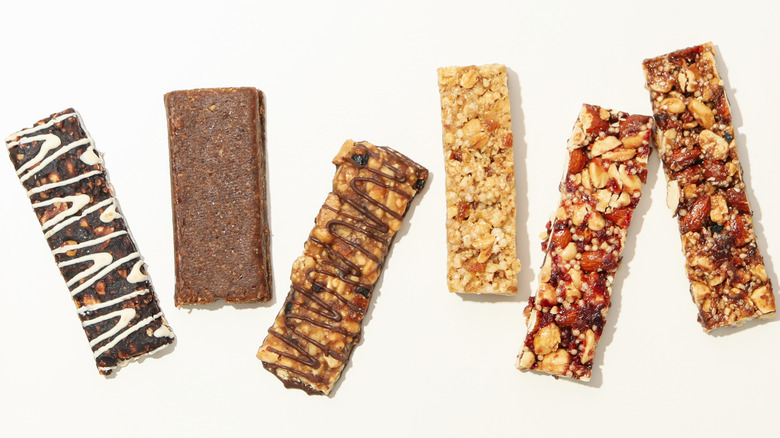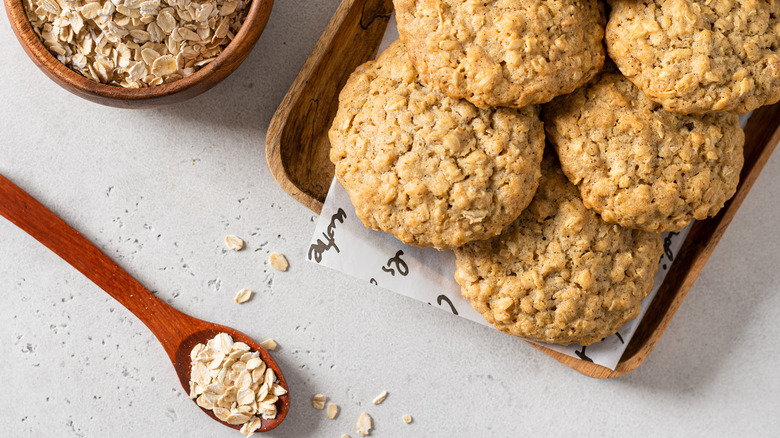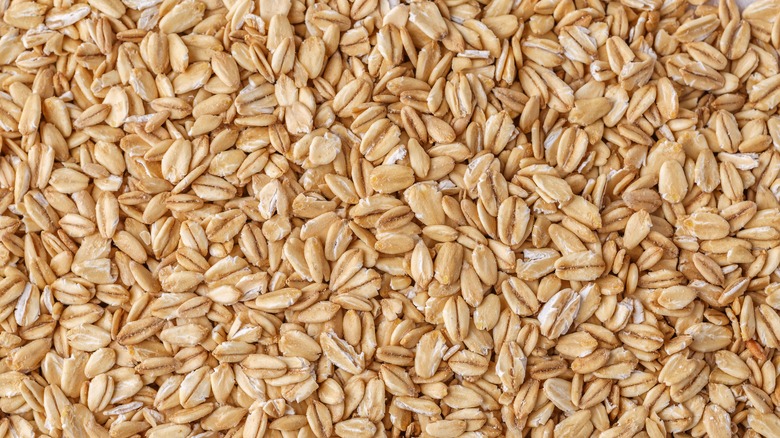7 Healthy Ways To Eat Oats And 7 Ways You Should Avoid
Nothing says comfort quite like digging into a steaming bowl of oats for breakfast. This popular gluten-free whole grain, also known as avena sativa, is absolutely yum-o-licious –– along with being a nutritional powerhouse (per Harvard School of Public Health). According to Healthline, eating oats can offer a wide range of health benefits. To start with, they are an excellent source of carbohydrates and fiber. Oats are also chock full of high-quality protein, vitamins, minerals, and antioxidants. Plus, eating oats regularly can keep your blood sugar and cholesterol levels in check, along with relieving constipation. Oats may even help you lose weight by helping you feel fuller for longer.
The problem is that most people don't want to just eat plain old raw oats (even though they are safe to eat raw, per Healthline). Preparing oatmeal for breakfast is one easy way to reap its nutritional benefits, but there are many other ways to incorporate oats into your diet. Some of these include smoothies, muffins, and cookies. You can even make a pizza crust out of oats (via Nutritious Life). Not surprisingly, some preparation methods are healthier than others. Below, we cover seven healthy ways to eat oats and seven ways you should avoid.
Healthy: Prepare oatmeal for breakfast
There are many health benefits that derive from eating oatmeal regularly for breakfast. Ginger Hultin, a spokesperson and registered dietician from the Academy of Nutrition and Dietetics, told Everyday Health: "Oatmeal is a healthy breakfast that's packed with complex carbohydrates (including fiber), vitamins, and minerals, and it can be an excellent vehicle for nutritious toppings like nuts, seeds, and fruit." Notably, a bowl of oatmeal offers up plenty of B vitamins, manganese, iron, magnesium, and zinc. All of these essential nutrients can help energize your body. Zinc also supports the body's immune system. Additionally, fiber found in oatmeal and other whole grains can provide protection against cardiovascular disease, type 2 diabetes, and some types of cancer, according to a 2019 meta-analysis published in The Lancet.
To prepare old-fashioned oats on the stove, Quaker Oats provides the following recipe for a single serving: Boil 1 cup water or milk, then stir in ½ cup of oats. Cook for about five minutes over medium heat, stirring on occasion. Alternatively, combine 1 cup of water or milk and ½ cup of oats with a dash of salt in a microwave-safe bowl, then cook in the microwave on high for 2 ½ to 3 minutes. Remember to give it a stir before eating. You can even prepare oatmeal in a rice cooker: Combine 1 ¾ cup of milk or water with ½ cup of oats and a dash of salt, cover, and turn your machine on. No matter how you choose to cook your oatmeal, enjoy!
Avoid: Loading up your oats with sugar
Sugar and syrup and honey, oh my! While sugar (in any form) may make your mouth water and oatmeal taste delicious, it can also be dangerous for your health. Eating too much added sugar can contribute to obesity and diabetes, along with affecting your cardiovascular system (per Harvard Health Publishing).
Harvard looked into "the sweet danger of sugar" with the help of Dr. Frank Hu, a nutrition professor at the Harvard T.H. Chan School of Public Health. Although the exact relationship between sugar and heart disease is not entirely understood, Dr. Hu explains how eating too much sugar can indirectly lead to heart disease: "Your liver metabolizes sugar the same way as alcohol, and converts dietary carbohydrates to fat." In this way, too much sugar can overwhelm your liver, cause fatty liver disease, and lead to diabetes. Diabetes, in turn, places you at increased risk for heart disease.
Keep in mind that just because you shouldn't overdo the sugar in your oatmeal doesn't mean you have to eat boring, bland oatmeal. Instead, get creative! For instance, you can mix in sugar substitutes, such as stevia. This sweetener is considered safe to use in moderation and is a "dietician favorite" (per the Cleveland Clinic). The right toppings can also improve your oatmeal's flavor without compromising its healthfulness — it's just all about portion control. Cooking Light recommends oatmeal toppers such as fruit, nuts, yogurt, cheese, and even bacon, limited to 100-calorie portions.
Healthy: Buy oat products with whole grain oats as the only ingredient
When you've walked down the cereal aisle lately, you've probably noticed an awful lot of oatmeal products on the market. Most of these products fall into one of three categories: steel-cut, old-fashioned (rolled), and instant oats. So which type should you buy? While that's open to some debate, Men's Journal declares that steel-cut oats are the healthiest option. This variety includes the bran, making it an excellent source of fiber. You may also find that steel-cut oats keep you full for longer, since they take more time to digest.
But old-fashioned oats are another great option, according to Cooking Light. They have a similar nutritional profile to steel-cut oats, with roughly the same amount of fiber. Even instant oats can be really good for you. The real trick to buying a healthy oatmeal product is to look for ones listing only one ingredient: whole grain oats. Beyond that, you may want to just choose your oat type based on personal preference. Cooking Light describes steel-cut oats as "sweet, nutty taste, and chewy consistency," while instant oats are "creamy and smooth." We think that old-fashioned oats fall somewhere in the middle.
You may want to factor in convenience when making your decision. Obviously, preparing non-instant oat varieties takes longer than heating instant ones. Some oatmeal enthusiasts make a large pot of steel-cut or old-fashioned oatmeal early in the week, then reheat single servings in the mornings (via Epicurious).
Avoid: Eating oats without protein
For an especially well-balanced, satisfying breakfast (and to avoid gaining weight), you may want to eat your oatmeal alongside a protein source. As Eat This, Not That! points out, oats on their own bring a lot of carbs to the table — and even though they do also contain protein, it may be worth adding a little more to offset the carbs. The good news is that mixing in a single tablespoon of nut butter contributes an additional 4 grams of protein and 8 grams of fat, which can help you stay full for longer and keep blood sugar levels in line. Another option to add protein is to place chopped or slivered nuts on top of your oatmeal.
Generally speaking, nuts and nut butters are super nutritious, along with being an excellent, plant-based protein source for vegetarians. A 2010 study in Nutrients describes the many health benefits of nut consumption. These include lowering the risks of sudden cardiac death, cardiovascular disease, and diabetes (in women). Plus, WebMD states that eating nuts can help you manage your weight, reduce cholesterol levels, and even protect against colon cancer.
Healthy: Add milk to your oats
Why prepare your oatmeal with water when you can use creamy, delicious milk instead? The addition of milk can even further boost your breakfast's high nutritional content. Cow's milk is rich in calcium, which promotes strong bones and teeth, as well as assisting with muscle movement and nerve signals (per Medical News Today). It is also high in potassium, which can help keep your blood pressure under control. Drinking milk may even ward off a number of health conditions, such as depression, osteoarthritis, and some types of cancer.
If you have an allergy or sensitivity to cow's milk, don't like the way it tastes, or prefer to avoid it due to ethical or environmental concerns, you can always substitute your favorite plant-based milk. There are plenty of options to choose from these days, including soy, almond, coconut, and rice milk –– you can even go with oat milk! Most plant-based milks at the store are fortified with vitamins D and A, and may also include vitamin B12, calcium, and riboflavin (per Good Housekeeping). Be sure to read those nutritional labels, though, since many plant-based milks include added sugars. To avoid this, select unsweetened varieties.
Avoid: Loading oatmeal with sugary toppings
We certainly understand the temptation to load on sugary oatmeal toppings. Popular options like chocolate chips and dried fruit can really do the trick taste-wise first thing in the morning. However, these toppings are not doing your health any favors. Just listen to this: ¼ cup of Ocean Spray Craisins adds 29 grams of sugar to your oatmeal, along with 33 grams of carbohydrates (per Eat This, Not That!). Unfortunately, this is not a healthy way to start off the day.
Instead, consider topping your oatmeal with fresh fruit. Have a Plant covers some of the many reasons why you may benefit from eating more fruits and vegetables –– whether on top of your oatmeal or elsewhere. First of all, fruits and vegetables contain fiber, which can keep you feeling satiated longer, regulate digestion, and reduce your risk of developing heart disease, diabetes, high blood pressure, and some types of cancer. Also, fruits and vegetables provide essential vitamins and minerals that your body needs to function properly. Finally, when you replace high-calorie foods with lower-calorie ones (like fruits and vegetables), you are less likely to gain weight and develop associated health problems.
Berries, which are rich in fiber, antioxidants, and vitamin C, may be an especially good option when it comes to disease prevention, according to Healthline. There are many types of healthy berries to choose from, including blueberries, raspberries, goji berries, and strawberries.
Healthy: Try an oat smoothie recipe
Of course, oatmeal isn't the only way to prepare oats. If you are looking for more variety, consider making a delicious, nutritious oat smoothie. This may be easier than you think, since Livestrong states that there is no need to cook your oats before blending them. However, although oats are perfectly safe to eat raw, keep in mind that uncooked oats have a rougher texture than cooked ones. That said, both raw and cooked oats can add important fiber to your diet, along with essential minerals like magnesium and zinc.
Quaker Oats provides a healthy recipe option with their fantastic Fruit Oat Smoothie. To prepare, simply blend together ½ cup oats, 1 cup skim milk, 1 medium banana, 14 frozen strawberries, ½ teaspoon vanilla extract, 1 ½ teaspoons honey, and 1 tablespoon of ground flaxseed (optional). Then, enjoy it cold. But this is just one option — there are a multitude of healthy smoothie recipes you can try (via Good Housekeeping).
Avoid: Buying most instant oatmeal packets
We want you to understand that instant oatmeal isn't in itself bad for you. In fact, it actually has a very similar nutritional profile to steel-cut and old fashioned varieties. Dr. Melina Jampolis, a physician nutrition specialist, states at CNN Health that "The only difference lies in the glycemic index, which is a measurement of how quickly a food increases your blood sugar within a two-hour period. Because instant oatmeal has been processed to cook more quickly, it is also broken down and digested more quickly by your body, giving it a higher glycemic index." She also explains that you can lower the glycemic index of instant oatmeal by adding lean protein, such as milk or protein powder, or a healthy fat source like nuts.
The real danger of instant oatmeal lies in its added ingredients, like sugar and salt. Since some varieties are worse offenders than others, it is very important to read nutrition labels (via Eat This, Not That!). You may wish to reach for Nature's Path Original Instant Oatmeal or Nature's Path Organic Maple Nut Hot Oatmeal. For a higher protein option, look for thinkThin's Farmer's Market Berry Crumble Oatmeal Single Serving Bowl. Products to avoid include Quaker's Instant Oatmeal Dinosaur Eggs Brown Sugar, Quaker Instant Oatmeal Raisins & Spice, and (surprise!) Quaker Weight Control Instant Oatmeal Maple & Brown Sugar.
Healthy: Consider savory options
Although we often think of oats as a sweet breakfast food, they can also be prepared in savory ways for lunch or dinner. Sound a little weird? We thought so, until we explored the multitude of options out there. For instance, Eat This, Not That! recommends a slew of creative concoctions with topping combinations such as eggs, avocado, and pepper; sun dried tomato, pesto, and parmesan; and mushrooms, caramelized onions, and bacon. Self also covers some interesting ways to eat oatmeal for dinner, most of which include adding a fried or poached egg, along with other savory ingredients. Their savory oats recipe collection includes a couple of unusual soup and risotto options as well.
If you need even more reasons to eat oats at night, here they are: Oats can improve your mood and may help you sleep better (per Pop Sugar). In terms of sleep, eating oats can boost insulin production, which helps tryptophan (the same natural sedative found in your Thanksgiving turkey) reach the brain. Oats also contain B6, which can help reduce stress, and melatonin (another natural sleep aid). For an even better night's sleep, you can also add in milk and bananas. Zzzzz.
Avoid: Last-minute oatmeal preparation
You know the old adage that good things are worth waiting for? Steel-cut and old-fashioned oatmeal varieties, which are considered healthier than most instant oatmeal packets (via CNN Health), take longer to make. Since not everybody has time to cook in the mornings, we have several grab-and-go solutions. First of all, you can plan ahead by batch-cooking oatmeal when you have the time, then quickly reheating smaller portions throughout the week. Another option, which some believe is even healthier, is to prepare overnight oats the night before. And if you really value convenience, you can even buy ready-to-eat overnight oats. (Mush brand is one option, offering clean ingredients.)
Bob's Red Mill describes how overnight oats are prepared, along with a number of reasons why you should try them. Instead of being cooked on the stove or in the microwave, overnight oats are soaked in liquid overnight in the refrigerator. You can use regular milk, your favorite plant-based milk, water, or even yogurt. This long, slow process breaks down the starches and natural phytic acid, thereby increasing digestibility. Although old-fashioned oats are most often used, any type of oats are fine. In the morning, overnight oats (or batch-cooked oats) can be warmed up or eaten straight out of the refrigerator.
Wholefully suggests adding chia seeds or ground flax seeds to thicken overnight oats, along with a natural sweetener and flavoring (i.e. vanilla extract). You can also mix in protein powder, espresso powder, citrus juice and zest, or other dietary boosts as desired.
Healthy: Bake oat muffins
If prepared in the right way, oat muffins can be a healthy way to consume oats (via The Joint Chiropractic). However, be sure to choose your recipes wisely. Some may involve only a small amount of oats, diluting most of their health benefits. Others include quite a lot of added sugar, which should be avoided.
While the American Heart Association (AHA) explains that nearly half of added sugars in the American diet come from sugary drinks, there's no doubt that you can find plenty of it in baked goods (including oat muffins), as well as in candy, cereals, dairy products, and desserts. Although the average adult consumes a whopping 17 teaspoons of sugar each day, the AHA recommends keeping that amount to no more than 9 teaspoons (for men) and 6 teaspoons (for women and children).
The good news is that you can still eat oat muffins. To control high sugar content and undesirable ingredients (like refined flour), The Joint Chiropractic suggests baking them at home. Store-bought muffins, even ones claiming to be healthy, are often sugar-bombs. Instead, look for fruit-sweetened recipes, such as Tastes Better from Scratch's healthy applesauce oat muffins –– yum!
Avoid: Purchasing a lot of packaged oat products
Many packaged oat products, such as granola and granola bars, are commonly touted as healthy foods (via Eat This, Not That!). But does this mean that they are always healthy? By now, you probably know that eating a lot of packaged and processed foods can affect your health, contributing to obesity and other dangerous health conditions (according to Medical News Today). Foods that are chemically processed (ultra-processed foods) often contain high amounts of sugar, refined carbohydrates, trans fats, and artificial ingredients. These products may also be low in fiber and nutrients.
CNN specifically explored whether granola is healthy. They point out that while granola contains healthy ingredients like oats, nuts, seeds, and dried fruit –– which can provide your body with protein, fiber, healthy fat, and other important nutrients –– it also tends to be high in calories. Registered dietitian Rahaf Al Bochi told CNN "It's important to be aware of the many sugar sources that could be in granola. Look for granola that has minimal amounts of added sugar and uses dried fruit for sweetness instead."
Keep in mind that not all granola products are bad. Verywell Fit recommends the Kashi Chewy Granola Bar Variety Pack, which has both clean ingredients and great flavors. You can also enjoy the KIND Healthy Grains Oats & Honey with Toasted Coconut Bar as a budget-friendly, healthy option.
Healthy(ish): Make oat cookies
Who doesn't love oatmeal cookies? Fortunately, you can add this item to your list of healthy ways to eat oats –– so long as your recipe doesn't contain a lot of added sugar, refined flour, and butter. We like this healthy oatmeal cookie recipe from Well Plated, which replaces half of the butter with applesauce and uses honey instead of refined sugar. It also suggests throwing in some dark chocolate chips and toasted nuts. Go ahead and enjoy –– in moderation. We know all too well how easy it can be to eat a lot of oatmeal cookies, which can result in an expanding waistline.
While it may be best to avoid store-bought varieties, most oat-based cookies at least offer more fiber than other cookie varieties (per SFGate). This makes them a better option when it comes to managing blood sugar levels. In other words, if you "have" to buy a store-bought cookie, an oatmeal variety might be the way to go.
Oatmeal cookies also provide a conduit for dried fruit, such as raisins. Beware: While dried fruit can provide important nutrition for the body, it can also be a hidden source of sugar (via Healthline). To keep your cookies low in sugar, go ahead and leave the dried fruit out. If you are gluten-intolerant or gluten-sensitive, oatmeal cookies are relatively easy to make gluten-free (via SFGate).
Avoid: Eating too many oats
Eating oats can boost your fiber intake, keep you satiated longer, and help you lose weight, according to Insider. But it is important to remember that eating too many oats can actually cause you to gain weight. Be sure to mind your portions, avoid overloading your oats with sugary sweeteners and toppings, and choose steel-cut or rolled oats over most instant oatmeal products.
Prevention recommends limiting oat portions to ½ cup uncooked oats, which yields about 1 cup cooked oats. Registered dietitian Jennifer Bowers also suggests serving oatmeal in a small bowl, where it may appear to be more satisfying.
Of course, the bottom line is that eating too much of anything, even healthy foods, can lead to weight gain and impact your overall health. To estimate your body's daily caloric needs, we suggest using an online calorie calculator. Simply enter your age, sex, height, weight, and activity level to determine how many daily calories are required to maintain or lose weight. To adhere to your daily budget, try using a calorie tracking app (via Good Housekeeping).

